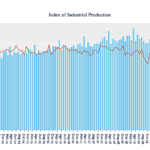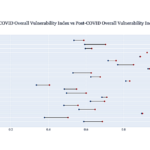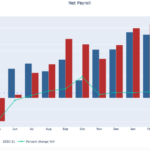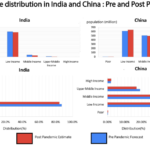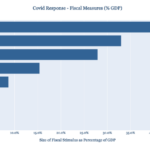CEDA EcoMeter: Under Covid’s shadow, economy hits a snag
On Monday, 31 st May 2021, the Indian government released the latest estimates of economic growth for the year 2020-21. India’s GDP contracted by 7.3 percent in 2020-21, as per these estimates. This follows a GDP growth of 4 percent in 2019-20. India’s average GDP growth in the last four years has been just 2.5 percent, partly because of the Covid pandemic.
The fourth quarter (Jan-Mar 2021) saw a growth of 1.6 percent. This follows a growth of 0.5 percent in the third quarter (Oct-Dec 2020). While GDP growth is an important indicator of the aggregate economic health of the country, it may be possible to assess the economic direction using other indicators. Such data is available at a higher frequency (weekly or monthly), provides a more recent and updated picture of the economy, and can help guide quick policy interventions. In this data narrative, we examine nine such indicators that can help us understand the trend of economic activity in the country. We list the variables in
Table 1.
Table 1

1. Google Mobility
Google’s Community Mobility Reports are aggregated, anonymized sets of data from users who have turned their location history on their phones on. These reports show how visits to places, such as workplaces, transit stations, retail and recreation, residential areas change with respect to baseline days. According to Google, “A baseline day represents a normal value for that day of the week. The baseline day is the median value from the 5‑week period Jan 3 – Feb 6, 2020.” For example, for India, retail and recreation mobility for May 31 is reported to be -37 percent. This means that visits to places such as restaurants, cafes, shopping centers, theme parks, libraries, and cinemas were down 37 percent on May 31 compared to the baseline day.
In Figure 1, we can see India’s aggregate mobility from this report. Transit mobility looks at visits to places that are public transport hubs. Workplace mobility tracks visits to workplaces while grocery and pharmacy mobility tracks visits to grocery or pharmacy stores.
Figure 1
Figure 1 shows that India’s aggregate productive mobility (retail & recreation, grocery & pharmacy, transit, workplace) is starting to show an uptick, signifying an increase in economic activity. Retail mobility shows the slowest recovery in May, followed by workplace mobility, and then transit mobility. Low retail mobility underlines the restrictions placed on retail sector in large parts of the country as part of state-wide lockdowns. Low retail mobility points to lower economic activity at the retail level.
Figure 2 looks at region-wise workplace mobility in India. While overall workplace mobility for India was down 42 percent (May 31), the chart shows changing trends across regions with the biggest improvement (in May) seen in Western India. This slight uptick in workplace mobility in May tallies with the fall in coronavirus cases in India, especially in western India. At the same time, we find South, and East India has not shown a similar uptick in recovery as North, and West India.
Figure 2
2. Electricity Consumption
Figure 3 looks at the average daily consumption of electricity (in Gigawatt-hours) in a month between April 2019 and May 2021. The changes in electricity consumption in 2019-20 correspond with the imposition of Covid lockdowns in the country in April and May 2020 and then subsequent loosening of controls. We saw a 24 percent decline in average daily consumption of electricity in April 2020 (over April 2019). However, we saw electricity consumption in April 2021 exceed April 2019 consumption by 6.5 percent. The worrying sign is the 10 percent decline in daily consumption in May 2021 over April 2021, a sign of restricted economic activity in the country owing to the second wave of the coronavirus pandemic. Although the trend has changed since 23 May and daily electricity consumption (7-day moving average), has been rising.
Figure 3
3. Unemployment Rate
Figure 4 shows the overall unemployment rate in India in 2019-20, 2020-21, and April-May 2021. The data is taken from the Centre for Monitoring Indian Economy (CMIE). While January, February, and March of 2021 experienced a lower unemployment rate than the corresponding months in 2020, the trend reversed in April 2021. We see a sharp rise in the overall unemployment rate in India in May 2021 at 11.9 percent.
Figure 4
To check whether this rise in unemployment is different across rural and urban India, we plot in Figure 5 the same graph as above separately for rural and urban regions. We find a sharper rise in unemployment in urban India in May 2021 to 14.73 percent, while in rural India unemployment rate in May 2021 was still high at 10.63 percent but lower than urban India.
Rising unemployment in April and May 2021 reflects the effects of the second wave of Covid-19 in India and highlights the weakness in economic activity.
Figure 5
4. CMIE Consumer Sentiment
Figure 6 charts CMIE’s Consumer Sentiment Index (CSI) between April 2019 and May 2021. The CMIE CSI helps us track the mood of households in India. We can see the sharp decline in CSI in April 2020 after the first national lockdown was imposed in India. Even though it recovered over 2020-21, it remains much lower than pre-Covid numbers. We also see a decline in CSI in sequential terms in April and May 2021. Thus, while GDP growth may have recovered in Q3 and Q4 of 2020-21, consumer sentiment remains low, signifying a lack of confidence in this economic recovery.
At the same time, Figure 7 shows us the changes in the daily Consumer Sentiment Index, and we observe that the decline in sentiment has been halted in the first week of June.
Figure 6
Figure 7
5. Railway Freight
Figure 8 shows us the trend in railway freight traffic from April 2019 to April 2021. Railways accounts for nearly one-third of all freight traffic in India underlining its importance for inter-regional trade, an important aspect of the Indian economy. In 2020-21, Indian Railways carried 1.2 billion tonnes of freight. After the April 2020 dip in railway freight, we saw a recovery to pre-pandemic levels in 2020-21. April 2021, however, saw a 14.4 percent dip in railway freight traffic over March 2021. This dip can perhaps be explained by the strong second wave of the coronavirus pandemic in many parts of the country which also led to state-wide lockdowns in many places.
Figure 8
6. GST Collections
Figure 9 shows the trend of monthly GST collections in the country from April 2019 to May 2021. April 2021 saw a record GST collection of Rs 1.41 trillion (up 14 percent over Rs 1.24 trillion in March 2021). While high GST collections in March and April 2021 were a sign of robust economic activity in the country, the picture might have been misleading as April 2021 collections would have also included GST revenue receipts from March that were posted in April. The second wave of the Covid pandemic affected India badly in April 2021 with states like Maharashtra, Gujarat, and Delhi hit the most. The impact of state lockdowns on economic activity in April 2021 (and therefore GST collections) is seen in GST collections in May 2021. GST collections fell by 27.35 percent (month-on-month) in May 2021 to Rs 1.03 trillion, presenting a more accurate picture of economic activity in India.
Figure 9
7. E-Way Bills
Under the GST regime, transporters are required to carry an Electronic Way Bill for the movement of goods. Any goods worth more than Rs 50,000 being transported by a GST registered person must have an e-way bill generated from the e-way bill portal. Generations of e-way bills can be taken as an indicator of economic activity (and GST collections) in the country. Figure 10 shows a dip in e-way bill generation in April 2021 compared to the previous month, reflecting a dip in economic activity in April 2021. This will likely get reflected on GST collections in May 2021.
Figure 10
8. PMI
Figure 11 shows us the Purchase Manager’s Index for Manufacturing and Services between April 2019 and May 2021. PMI helps gauge whether purchase managers (supply chain managers) in manufacturing or services are looking to expand or reduce activity. In PMI, a score of above 50 signifies the expansion of activity and a score lower than 50 signifies contraction. In May 2021, Manufacturing PMI hit a ten-month low of 50.8. It was thus, on the verge of contraction. Services PMI had a score of 46.4 in May 2021, showing a significant contraction in services activity in the month of May. This is the lowest number for Services PMI in 9 months. According to the survey, demand had been dampened because of the second wave of the coronavirus pandemic.
Figure 11
Conclusion: Covid continues to cast a long shadow on the economy
The second wave of the coronavirus pandemic has put a stop to the slow gains in economic activity made between October 2020 and March 2021. The strong impact of this second wave is clearly visible in the dip in average daily consumption of electricity in the month of May 2021 when compared to a month ago. The contraction in PMI-Services, the near-contraction in PMI-Manufacturing in May, and the sharp dip in GST collections in May 2021 tell us that economic activity has hit a snag in April and May. At the same time, we do see the decline halting in the case of some of these high-frequency variables like Google Mobility, consumer sentiment, and daily electricity consumption. But on the evidence of all the available data, it may be fair to say that the demand side of the economy will remain a concern in the medium-term and that the Covid pandemic will continue to cast a long shadow on the Indian economy.
Author’s Note: Sikkim, Arunachal Pradesh, Mizoram, Dadra and Nagar Haveli, Jammu and Kashmir, Daman and Diu have been excluded in computing mobility data in Figure 2 because they had outlier values. Region-wise mobility is computed by taking the mean of the states of their respective regions.
If you wish to republish this article or use an extract or chart, please read CEDA’s republishing guidelines.




